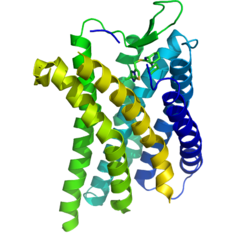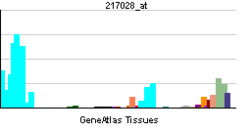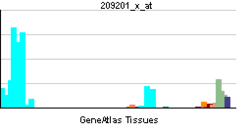- CXCR4
-
C-X-C chemokine receptor type 4 (CXCR-4) also known as fusin or CD184 (cluster of differentiation 184) is a protein that in humans is encoded by the CXCR4 gene.[1][2]
Contents
Function
CXCR-4 is an alpha-chemokine receptor specific for stromal-derived-factor-1 (SDF-1 also called CXCL12), a molecule endowed with potent chemotactic activity for lymphocytes. This receptor is one of several chemokine receptors that HIV isolates can use to infect CD4+ T cells. HIV isolates that use CXCR4 are traditionally known as T-cell tropic isolates. Typically, these viruses are found late in infection. It is unclear as to whether the emergence of CXCR4-using HIV is a consequence or a cause of immunodeficiency.
CXCR4 is upregulated during the implantation window in natural and hormone replacement therapy cycles in the endometrium, producing, in presence of a human blastocyst, a surface polarization of the CXCR4 receptors suggesting that this receptor is implicated in the adhesion phase of human implantation.
CXCR4's ligand SDF-1 is known to be important in hematopoietic stem cell homing to the bone marrow and in hematopoietic stem cell quiescence. Until recently, SDF-1 and CXCR4 were believed to be a relatively "monogamous" ligand-receptor pair (other chemokines tend to use several different chemokine receptors in a fairly "promiscuous" manner). Recent evidence demonstrates ubiquitin is also a natural ligand of CXCR4.[3] Ubiquitin is a small (76-amino acid) protein highly conserved among eukaryotic cells. It is best known for its intracellular role in targeting ubiquitylated proteins for degradation via the ubiquitin proteasome system. Evidence in numerous animal models suggests ubiquitin is anti-inflammatory immune modulator and endogenous opponent of proinflammatory damage associated molecular pattern molecules.[4] It is speculated this interaction may be through CXCR4 mediated signalling pathways.
Clinical significance
Drugs that block the CXCR4 receptor appear to be capable of "mobilizing" hematopoietic stem cells into the bloodstream as peripheral blood stem cells. Peripheral blood stem cell mobilization is very important in hematopoietic stem cell transplantation (as a recent alternative to transplantation of surgically-harvested bone marrow) and is currently performed using drugs such as G-CSF. G-CSF is a growth factor for neutrophils (a common type of white blood cells), and may act by increasing the activity of neutrophil-derived proteases such as neutrophil elastase in the bone marrow leading to proteolytic degradation of SDF-1. Plerixafor (AMD3100) is a drug, recently approved for routine clinical use[5], which directly blocks the CXCR4 receptor. It is a very efficient inducer of hematopoietic stem cell mobilization in animal and human studies.
It has been associated with WHIM syndrome.[6]
Drug response
Chronic exposure to THC increased T lymphocyte CXCR4 expression on both CD4+ and CD8+ T lymphocytes. [7]
Interactions
CXCR4 has been shown to interact with USP14.[8]
See also
- HIV tropism
- Entry inhibitor
- Discovery and development of CCR5 receptor antagonists
References
- ^ Moriuchi M, Moriuchi H, Turner W, Fauci AS (November 1997). "Cloning and analysis of the promoter region of CXCR4, a coreceptor for HIV-1 entry". J. Immunol. 159 (9): 4322–9. PMID 9379028.
- ^ Caruz A, Samsom M, Alonso JM, Alcami J, Baleux F, Virelizier JL, Parmentier M, Arenzana-Seisdedos F (April 1998). "Genomic organization and promoter characterization of human CXCR4 gene". FEBS Lett. 426 (2): 271–8. doi:10.1016/S0014-5793(98)00359-7. PMID 9599023.
- ^ Saini V, Marchese A, Majetschak M (May 2010). "CXC chemokine receptor 4 is a cell surface receptor for extracellular ubiquitin". J. Biol. Chem. 285 (20): 15566–76. doi:10.1074/jbc.M110.103408. PMC 2865327. PMID 20228059. http://www.pubmedcentral.nih.gov/articlerender.fcgi?tool=pmcentrez&artid=2865327.
- ^ Majetschak M (August 2010). "Extracellular ubiquitin: immune modulator and endogenous opponent of damage-associated molecular pattern molecules". J Leukoc Biol 89 (2): 205–219. doi:10.1189/jlb.0510316. PMID 20689098.
- ^ Bik To, L, et al; How I treat patients who mobilize hematopoietic stem cells poorly; Blood;Vol 118/Num 17: 27 Oct 2011;
- ^ Balabanian K, Levoye A, Klemm L, et al. (March 2008). "Leukocyte analysis from WHIM syndrome patients reveals a pivotal role for GRK3 in CXCR4 signaling". J. Clin. Invest. 118 (3): 1074–84. doi:10.1172/JCI33187. PMC 2242619. PMID 18274673. http://www.pubmedcentral.nih.gov/articlerender.fcgi?tool=pmcentrez&artid=2242619.
- ^ Lecapitaine, N.; Zhang, P.; Winsauer, P.; Walker, E.; Vande Stouwe, C.; Porretta, C.; Molina, P. (2011). "Chronic Δ-9-tetrahydrocannabinol Administration Increases Lymphocyte CXCR4 Expression in Rhesus Macaques". Journal of neuroimmune pharmacology : the official journal of the Society on NeuroImmune Pharmacology. doi:10.1007/s11481-011-9277-4. PMID 21484257.
- ^ Mines MA, Goodwin JS, Limbird LE, Cui FF, Fan GH (February 2009). "Deubiquitination of CXCR4 by USP14 is critical for both CXCL12-induced CXCR4 degradation and chemotaxis but not ERK ativation". J. Biol. Chem. 284 (9): 5742–52. doi:10.1074/jbc.M808507200. PMC 2645827. PMID 19106094. http://www.pubmedcentral.nih.gov/articlerender.fcgi?tool=pmcentrez&artid=2645827.
Further reading
- Wilkinson D (1997). "Cofactors provide the entry keys. HIV-1.". Curr. Biol. 6 (9): 1051–3. doi:10.1016/S0960-9822(02)70661-1. PMID 8805353.
- Broder CC, Dimitrov DS (1997). "HIV and the 7-transmembrane domain receptors.". Pathobiology 64 (4): 171–9. doi:10.1159/000164032. PMID 9031325.
- Choe H, Martin KA, Farzan M, et al. (1998). "Structural interactions between chemokine receptors, gp120 Env and CD4.". Semin. Immunol. 10 (3): 249–57. doi:10.1006/smim.1998.0127. PMID 9653051.
- Freedman BD, Liu QH, Del Corno M, Collman RG (2004). "HIV-1 gp120 chemokine receptor-mediated signaling in human macrophages.". Immunol. Res. 27 (2-3): 261–76. doi:10.1385/IR:27:2-3:261. PMID 12857973.
- Esté JA (2004). "Virus entry as a target for anti-HIV intervention.". Curr. Med. Chem. 10 (17): 1617–32. doi:10.2174/0929867033457098. PMID 12871111.
- Gallo SA, Finnegan CM, Viard M, et al. (2003). "The HIV Env-mediated fusion reaction.". Biochim. Biophys. Acta 1614 (1): 36–50. doi:10.1016/S0005-2736(03)00161-5. PMID 12873764.
- Zaitseva M, Peden K, Golding H (2003). "HIV coreceptors: role of structure, posttranslational modifications, and internalization in viral-cell fusion and as targets for entry inhibitors.". Biochim. Biophys. Acta 1614 (1): 51–61. doi:10.1016/S0005-2736(03)00162-7. PMID 12873765.
- Lee C, Liu QH, Tomkowicz B, et al. (2004). "Macrophage activation through CCR5- and CXCR4-mediated gp120-elicited signaling pathways.". J. Leukoc. Biol. 74 (5): 676–82. doi:10.1189/jlb.0503206. PMID 12960231.
- Yi Y, Lee C, Liu QH, et al. (2004). "Chemokine receptor utilization and macrophage signaling by human immunodeficiency virus type 1 gp120: Implications for neuropathogenesis.". J. Neurovirol.. 10 Suppl 1: 91–6. PMID 14982745.
- Seibert C, Sakmar TP (2004). "Small-molecule antagonists of CCR5 and CXCR4: a promising new class of anti-HIV-1 drugs.". Curr. Pharm. Des. 10 (17): 2041–62. doi:10.2174/1381612043384312. PMID 15279544.
- Perfettini JL, Castedo M, Roumier T, et al. (2006). "Mechanisms of apoptosis induction by the HIV-1 envelope.". Cell Death Differ.. 12 Suppl 1: 916–23. doi:10.1038/sj.cdd.4401584. PMID 15719026.
- King JE, Eugenin EA, Buckner CM, Berman JW (2006). "HIV tat and neurotoxicity.". Microbes Infect. 8 (5): 1347–57. doi:10.1016/j.micinf.2005.11.014. PMID 16697675.
- Kryczek I, Wei S, Keller E, et al. (2007). "Stroma-derived factor (SDF-1/CXCL12) and human tumor pathogenesis.". Am. J. Physiol., Cell Physiol. 292 (3): C987–95. doi:10.1152/ajpcell.00406.2006. PMID 16943240.
- Arya M, Ahmed H, Silhi N, et al. (2007). "Clinical importance and therapeutic implications of the pivotal CXCL12-CXCR4 (chemokine ligand-receptor) interaction in cancer cell migration.". Tumour Biol. 28 (3): 123–31. doi:10.1159/000102979. PMID 17510563.
- Grange JM (1980). "Tuberculosis: the changing tubercle.". British journal of hospital medicine 22 (6): 540–8. PMID 118789.
- Nomura H, Nielsen BW, Matsushima K (1994). "Molecular cloning of cDNAs encoding a LD78 receptor and putative leukocyte chemotactic peptide receptors.". Int. Immunol. 5 (10): 1239–49. doi:10.1093/intimm/5.10.1239. PMID 7505609.
- Lu ZH, Wang ZX, Horuk R, et al. (1995). "The promiscuous chemokine binding profile of the Duffy antigen/receptor for chemokines is primarily localized to sequences in the amino-terminal domain.". J. Biol. Chem. 270 (44): 26239–45. doi:10.1074/jbc.270.44.26239. PMID 7592830.
- Jazin EE, Yoo H, Blomqvist AG, et al. (1993). "A proposed bovine neuropeptide Y (NPY) receptor cDNA clone, or its human homologue, confers neither NPY binding sites nor NPY responsiveness on transfected cells.". Regul. Pept. 47 (3): 247–58. doi:10.1016/0167-0115(93)90392-L. PMID 8234909.
- Loetscher M, Geiser T, O'Reilly T, et al. (1994). "Cloning of a human seven-transmembrane domain receptor, LESTR, that is highly expressed in leukocytes.". J. Biol. Chem. 269 (1): 232–7. PMID 8276799.
- Federsppiel B, Melhado IG, Duncan AM, et al. (1993). "Molecular cloning of the cDNA and chromosomal localization of the gene for a putative seven-transmembrane segment (7-TMS) receptor isolated from human spleen.". Genomics 16 (3): 707–12. doi:10.1006/geno.1993.1251. PMID 8325644.
External links
- "Chemokine Receptors: CXCR4". IUPHAR Database of Receptors and Ion Channels. International Union of Basic and Clinical Pharmacology. http://www.iuphar-db.org/GPCR/ReceptorDisplayForward?receptorID=2216.
Cytokine receptors Chemokine receptor
(GPCRs)OtherTNF receptor 1-1011-2021-25JAK-STAT OtherIg superfamily IL-17 family S/T 1-50 CD1 (a-c, 1A, 1D, 1E) · CD2 · CD3 (γ, δ, ε) · CD4 · CD5 · CD6 · CD7 · CD8 (a) · CD9 · CD10 · CD11 (a, b, c) · CD13 · CD14 · CD15 · CD16 (A, B) · CD18 · CD19 · CD20 · CD21 · CD22 · CD23 · CD24 · CD25 · CD26 · CD27 · CD28 · CD29 · CD30 · CD31 · CD32 (A, B) · CD33 · CD34 · CD35 · CD36 · CD37 · CD38 · CD39 · CD40 · CD41 · CD42 (a, b, c, d) · CD43 · CD44 · CD45 · CD46 · CD47 · CD48 · CD49 (a, b, c, d, e, f) · CD5051-100 CD51 · CD52 · CD53 · CD54 · CD55 · CD56 · CD57 · CD58 · CD59 · CD61 · CD62 (E, L, P) · CD63 · CD64 (A, B, C) · CD66 (a, b, c, d, e, f) · CD68 · CD69 · CD70 · CD71 · CD72 · CD73 · CD74 · CD78 · CD79 (a, b) · CD80 · CD81 · CD82 · CD83 · CD84 · CD85 (a, d, e, h, j, k) · CD86 · CD87 · CD88 · CD89 · CD90 · CD91- CD92 · CD93 · CD94 · CD95 · CD96 · CD97 · CD98 · CD99 · CD100101-150 CD101 · CD102 · CD103 · CD104 · CD105 · CD106 · CD107 (a, b) · CD108 · CD109 · CD110 · CD111 · CD112 · CD113 · CD114 · CD115 · CD116 · CD117 · CD118 · CD119 · CD120 (a, b) · CD121 (a, b) · CD122 · CD123 · CD124 · CD125 · CD126 · CD127 · CD129 · CD130 · CD131 · CD132 · CD133 · CD134 · CD135 · CD136 · CD137 · CD138 · CD140b · CD141 · CD142 · CD143 · CD144 · CD146 · CD147 · CD148 · CD150151-200 CD151 · CD152 · CD153 · CD154 · CD155 · CD156 (a, b, c) · CD157 · CD158 (a, d, e, i, k) · CD159 (a, c) · CD160 · CD161 · CD162 · CD163 · CD164 · CD166 · CD167 (a, b) · CD168 · CD169 · CD170 · CD171 · CD172 (a, b, g) · CD174 · CD177 · CD178 · CD179 (a, b) · CD181 · CD182 · CD183 · CD184 · CD185 · CD186 · CD191 · CD192 · CD193 · CD194 · CD195 · CD196 · CD197 · CDw198 · CDw199 · CD200201-250 CD201 · CD202b · CD204 · CD205 · CD206 · CD207 · CD208 · CD209 · CDw210 (a, b) · CD212 · CD213a (1, 2) · CD217 · CD218 (a, b) · CD220 · CD221 · CD222 · CD223 · CD224 · CD225 · CD226 · CD227 · CD228 · CD229 · CD230 · CD233 · CD234 · CD235 (a, b) · CD236 · CD238 · CD239 · CD240CE · CD240D · CD241 · CD243 · CD244 · CD246 · CD247- CD248 · CD249251-300 CD252 · CD253 · CD254 · CD256 · CD257 · CD258 · CD261 · CD262 · CD264 · CD265 · CD266 · CD267 · CD268 · CD269 · CD271 · CD272 · CD273 · CD274 · CD275 · CD276 · CD278 · CD279 · CD280 · CD281 · CD282 · CD283 · CD284 · CD286 · CD288 · CD289 · CD290 · CD292 · CDw293 · CD294 · CD295 · CD297 · CD298 · CD299301-350 Categories:- Human proteins
- Chemokine receptors
- Cell biology stubs
Wikimedia Foundation. 2010.




